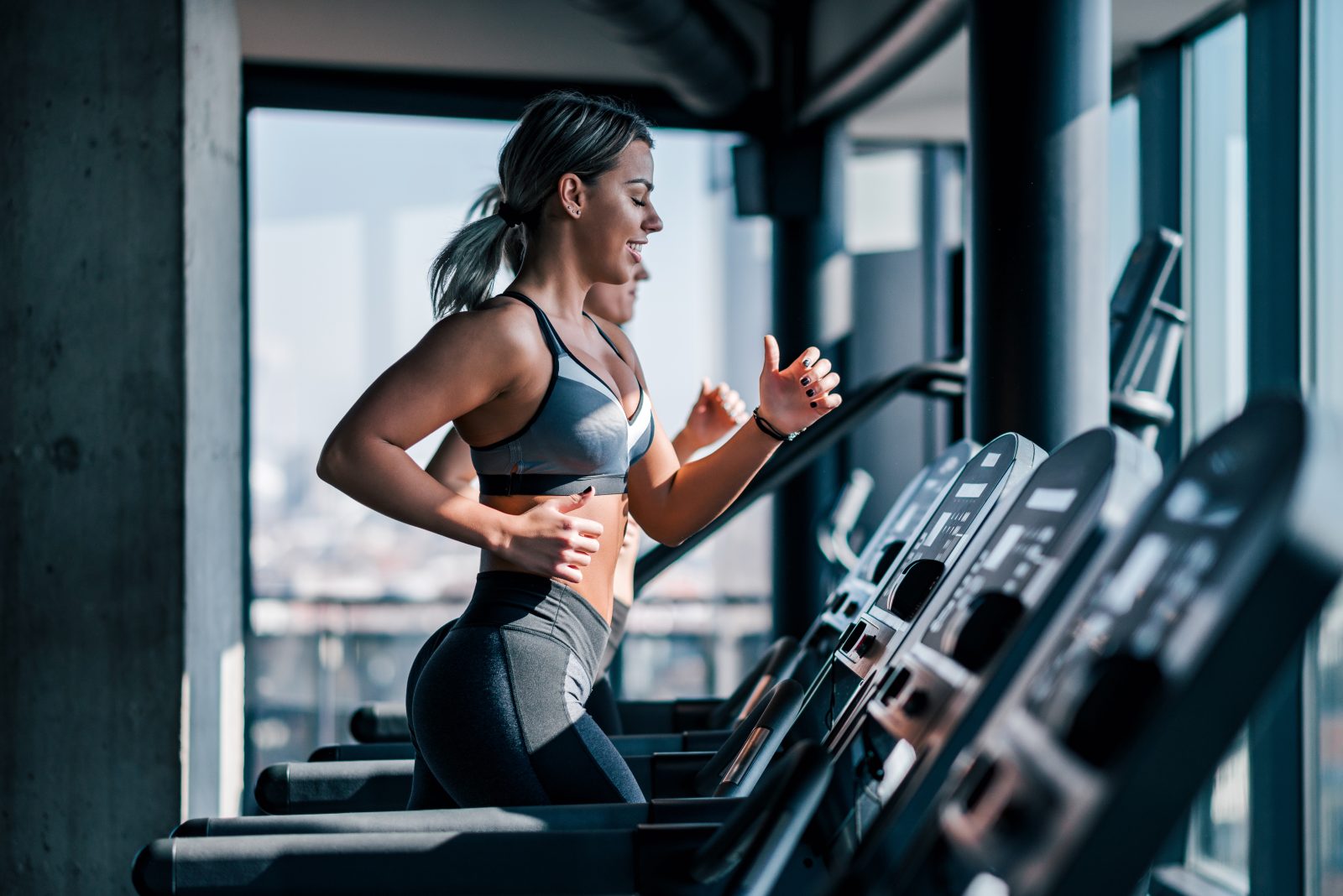When aiming to achieve the 150 minutes of moderate-intensity aerobic activity per week recommended by the Centers for Disease Control and Prevention (CDC), gym-goers often find themselves debating which piece of cardio equipment to use.
With options like treadmills, exercise bikes, ellipticals, stair climbers, and rowers, making the right choice can be challenging.
This article gives you all the information you need on each, to be able to choose the one that best suits your fitness routine and goals.
The Role of Cardio Machines
Cardio machines are designed to improve cardiovascular health by increasing your heart and respiratory rate, which strengthens the heart muscle and builds endurance. Some machines also offer strength-building benefits.
When selecting the right machine, it is essential to consider factors such as age, functionality, mobility, existing health conditions, and specific fitness goals.
While cardio is important for your heart, lungs, and overall well-being, it is important to learn about cardio and heart conditions in order to perform exercises safely.
The Treadmill: A Staple in Cardio Fitness
What It Is
A treadmill features a moving belt that allows for walking or running in place. It is one of the most common and widely used cardio machines in gyms.
Muscles Targeted
The treadmill primarily builds cardiovascular endurance. Walking or running also engages lower body muscles, including the quadriceps, glutes, hamstrings, and calves. However, it is not the most effective way to build muscle strength.
Pros
- You can vary the speed and incline to increase workout intensity or perform interval and HIIT workouts.
- A study published in the Journal of Sports Science & Medicine found that treadmills burn more fat compared to ellipticals and rowers (though the study had a limited sample size).
Cons
- Treadmills can be higher-impact, potentially straining joints, especially compared to outdoor tracks or turf.
- Improper use, such as looking at a phone or holding onto the rails, can strain the neck and affect walking form. Staying centered on the belt without holding on is crucial for safety.
The Elliptical Machine: Low-Impact and Full-Body Workout
What It Is
An elliptical machine features large pedals that move in a circular motion and handlebars that move back and forth, allowing for a full-body workout while standing.
Muscles Targeted
Ellipticals work the quads, hamstrings, and calves, especially when resistance is increased. Without substantial resistance, the workout remains primarily cardiovascular.
Pros
- The elliptical is gentle on the joints, making it ideal for beginners, those recovering from injury, or people undergoing physical therapy.
- Ellipticals are recommended for individuals with physical disabilities, such as cerebral palsy and multiple sclerosis, due to their low-impact nature.
Cons
- Common mistakes include hunching, lifting heels, or leaning too far back. Maintaining the correct posture and center of gravity is essential for an effective workout.
- Without challenging resistance, the workout may not provide significant muscle strengthening.
Rowing Machine: Total-Body Conditioning with Low Impact
What It Is
A rowing machine is a piece of equipment where you sit on a sliding seat and use both hands to pull a handle, mimicking the rowing motion of a boat.
Muscles Targeted
The rowing machine works multiple muscle groups including the upper back and shoulders, quads, calves, and glutes during both the pushback and pull phases.
Pros
- Provides a total-body workout, engaging muscles in the upper back, shoulders, quads, calves, and glutes.
- Offers both cardiovascular benefits and muscle strengthening in one machine.
- Adjustable resistance levels allow customization of workouts – lower resistance for cardio-focused sessions, higher resistance for muscle activation.
- Low-impact exercise that reduces strain on joints compared to high-impact activities like running.
- Suitable for all fitness levels, from beginners to advanced athletes.
Cons
- Beginners may find the rowing motion unfamiliar initially, but it becomes natural with practice.
- Start at a low resistance level to master technique and prevent muscle strain.
- Gradually increase resistance as strength and endurance improve to avoid overexertion.
- Proper form is crucial to prevent injury; ensure your back is straight, shoulders relaxed, and core engaged throughout the motion.
- If you have existing back or shoulder issues, consult with a fitness professional before using a rowing machine to avoid exacerbating these conditions.
Exercise Bike: Low-Impact Cardio with Adjustable Intensity
What It Is
Indoor or stationary exercise bikes come in various styles, each designed to cater to different workout needs and preferences:
- Air Bike: Uses air resistance created by pedaling, offering a dynamic resistance level that increases with speed.
- Spin or Indoor Bike: Features manually adjustable resistance, making it suitable for high-intensity interval training (HIIT) and endurance rides.
- Recumbent Bike: Designed with a reclined seating position, providing support for the lower back and a more comfortable workout for those with limited mobility or back issues.
Muscles Targeted
The primary muscles worked while cycling include the quadriceps and hamstrings. These muscle groups are heavily engaged during the pedaling motion.
Additionally, by increasing the resistance, users can significantly build lower-body muscle strength, targeting the calves and glutes as well.
Pros
- Users can increase the resistance and even stand up to pedal on certain styles, simulating hill climbing and intensifying the workout.
- Ideal for individuals recovering from lower-extremity injuries or those with balance issues, as the fixed position of the feet reduces the risk of falls.
- Gentle on the joints, making it suitable for people with joint pain or arthritis.
Cons
- Those with anterior knee pain (pain in the front of the knee) may find that the pedaling motion exacerbates their discomfort. In such cases, an elliptical machine might be a better alternative due to its different motion and lower impact on the knees.
Stair Climber: High-Intensity Workout for Maximum Calorie Burn
What It Is
A stair climber simulates the action of climbing stairs. There are several types, including:
- Features revolving, escalator-like stairs, providing a continuous step workout.
- Has individual pedals for each foot, allowing users to step up and down at their own pace.
- Ladder-like devices that engage both the upper and lower body by simulating climbing.
Muscles Targeted
Stair climbers effectively activate the glutes, quadriceps, and calves. The intensity and repetitive motion provide both a cardio and strength workout, particularly when resistance is added.
Pros
- Stair climbing is inherently high-intensity, making it one of the most effective cardio machines for burning calories.
- The adjustable resistance on stair steppers allows for significant muscle strengthening, particularly in the lower body.
- Due to its high intensity, stair climbing burns a substantial number of calories in a relatively short amount of time.
Cons
- The high intensity may limit the duration of the workout, especially for beginners or those with lower fitness levels.
- Individuals with knee or hip problems may experience aggravated pain with the repetitive stepping motion. An elliptical may be a more joint-friendly alternative.
- It’s common to use handrails for support, which can lead to improper form and excess pressure on the shoulders and wrists. It’s important to maintain proper posture and reduce speed if necessary.
Wrap-Up
Selecting the right cardio machine is crucial for achieving your fitness goals effectively and safely. Whether you prefer the straightforward motion of a treadmill, the full-body engagement of an elliptical, the total-body conditioning of a rowing machine, the low-impact cycling on an exercise bike, or the calorie-burning intensity of a stair climber, each option offers unique benefits tailored to different fitness levels and objectives.
Remember to consider factors such as your current fitness level, any existing health conditions, and specific goals when making your choice. Experiment with different machines to find what feels most comfortable and enjoyable for you.
If you found this guide helpful, please share it with others who might benefit from understanding their cardio machine options better.
















Find Us on Socials